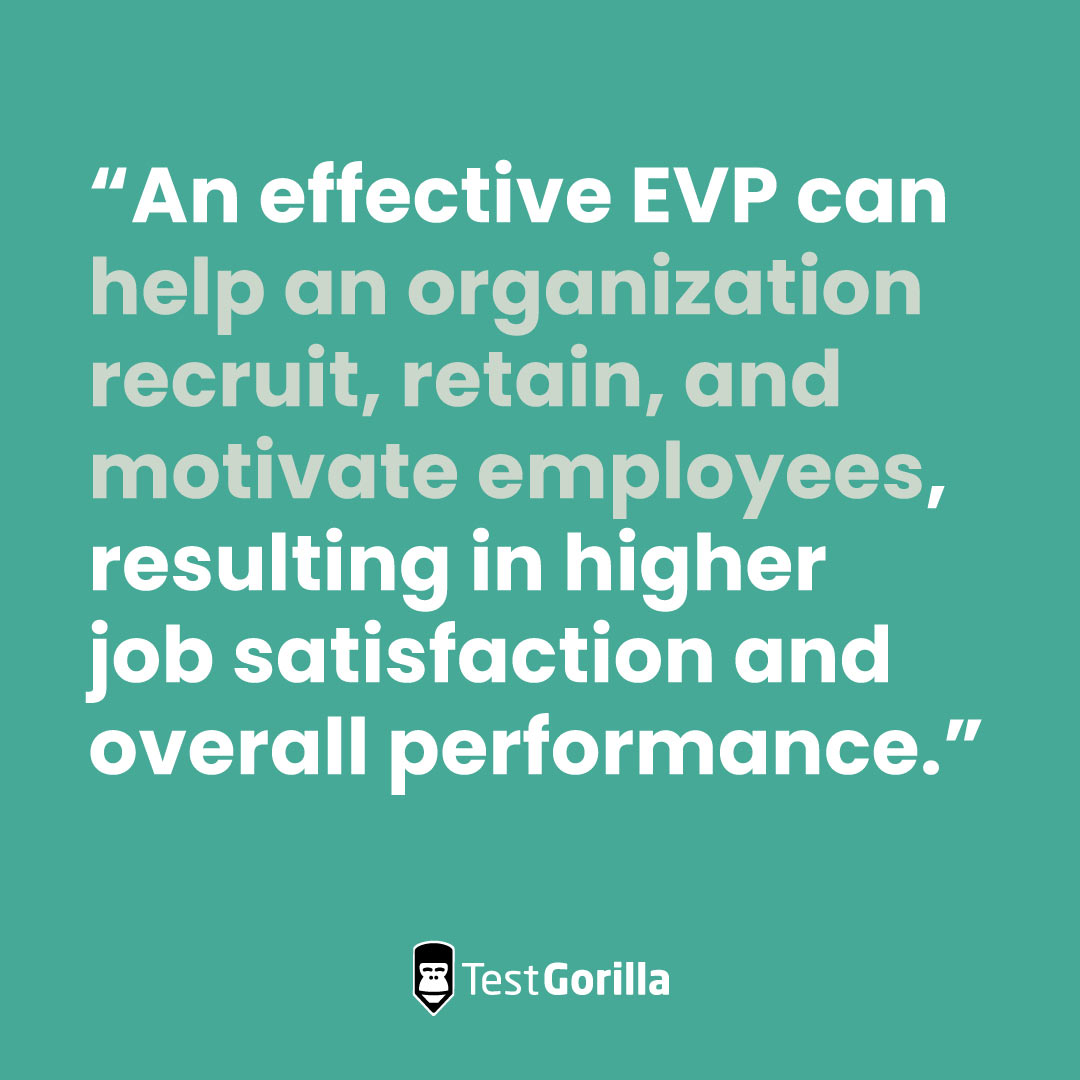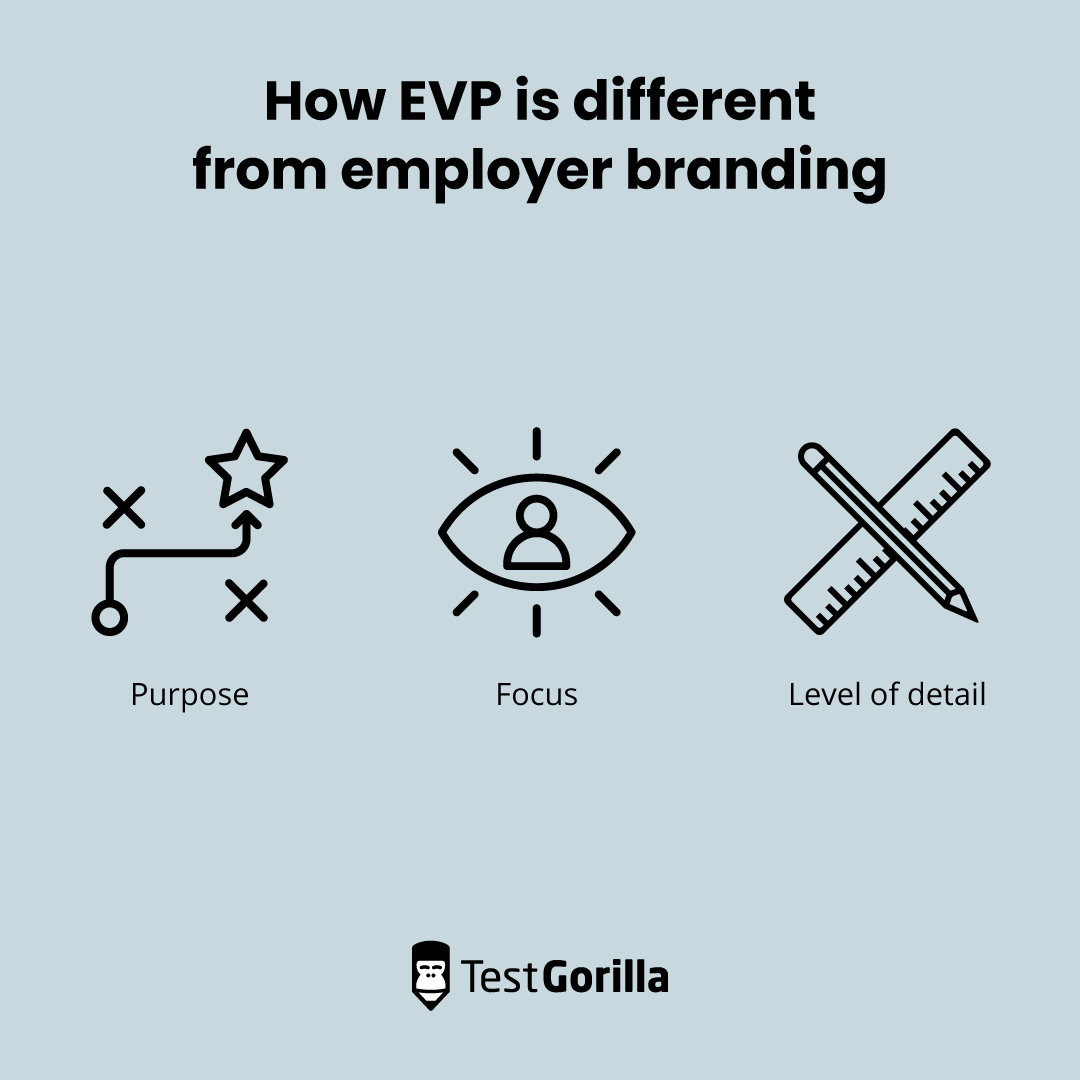It can take as little as 30 seconds to form a first impression. And that doesn't just mean face-to-face meetings — candidates make their first judgments of your employer brand from a skim read of your website and job descriptions.
In this short window, candidates form a first impression about your company culture, values, and what it would be like to work for your business. It's crucial to have a strong employer brand and a high-quality employee value proposition (EVP)to help attract top talent, stand out in a competitive labor market, and retain your skilled employees.
In this article, we explore what an EVP and employer brand are, their differences, and how you can use your EVP to strengthen your employer brand.
What is an employee value proposition?
An employee value proposition (EVP) is an employee's total reward package for working at your business. This includes financial rewards like salary and bonuses. It also includes non-financial rewards like free training opportunities, flexible working options, and development opportunities.
Other workplace benefits might include:
Medical and dental insurance
Paid overtime
Paid time off (PTO)
Retirement plans
Great company culture
Family-friendly policies like parental leave
Reward programs
Diversity and inclusion initiatives
Employee Assistance Programs (EAP)
Ensure you highlight the unique benefits of working for your business. Otherwise, you risk being outdone by your competitors.
An effective EVP can help an organization recruit, retain, and motivate employees, resulting in higher job satisfaction and overall performance. Your EVP is different from your employer brand. However, a great EVP will contribute significantly to your employer brand.
Further reading: How to write an employee value proposition (EVP) (+ examples)
What is an employer brand?
Your employer brand is how your business is seen by potential applicants and current employees. It’s hard to measure as it’s determined by the general impression that your business gives off. Your employer brand can be influenced by:
Total reward package
The recruitment process
Workplace policies
Treatment of employees
Branding and marketing
Employee word of mouth
Social responsibility
Brand image
Employer brand is different from corporate identity. It's shaped by your company's workplace culture, the treatment of employees, and the actual experiences people have working for your organization.
Your corporate identity is how your business presents itself to the public, for example, through brand colors, communication styles, and marketing techniques.
Changing your corporate identity is easy, but improving your employer brand can be trickier. It requires consistent efforts to build a positive reputation over time. This is achieved by focusing on the employee experience, addressing shortcomings, and improving communication with applicants. Sometimes, it may involve a fundamental shift in the company's culture and policies.
The best insights on HR and recruitment, delivered to your inbox.
Biweekly updates. No spam. Unsubscribe any time.
How EVP is different from employer branding
Although your EVP can contribute to your employer brand, there are distinct differences between the two.
Purpose
An EVP aims to align what your organization offers with the expectations of current and potential employees. Creating a great EVP involves speaking to current employees, benchmarking against other businesses, and conducting market research. This process ensures you fairly compensate employees for their efforts and that the overall employee experience is competitive in the current job market.
Employer branding aims to change how current recruits and potential applicants think about your business. It's about creating an attractive and positive identity that resonates with both current employees and potential candidates.
Focus
Your EVP will focus on the benefits and rewards offered to your employees in exchange for their time, efforts, and expertise. Employer branding focuses on how candidates perceive your business and people's experiences working for the organization.
Level of detail
Your EVP will be specific and detailed. It will contain what your candidates or employees can expect in exchange for working with your business.
our employer brand will be broader and will focus on your organization’s perception as an employer. This information is often difficult to quantify as it’s opinion-based. As a result, it will need ongoing monitoring to ensure you portray your brand in the best light.
Using EVPs to enhance your employer brand
A strong EVP is a powerful tool for boosting your employer brand. Here's how to do it.
Make your EVP compelling
Writing an engaging and persuasive EVP is the first step to enhancing your employer brand. Suppose your EVP doesn’t correctly highlight the benefits of working for your business. In that case, you risk missing out on attracting top talent and retaining your current employees.
Similarly, if your EVP overpromises your offerings, your employees could feel misled. This can lead to decreased morale and frustration.
It’s essential to strike a balance in your EVP, ensuring you’re honest about the strengths and advantages of your workplace without overselling your perks. Here’s some guidance on how to write a great EVP.
Utilize current employees
Speak to your current employees about what it’s like to work for your business. Ask them which benefits they get the most use from and whether they feel there are any gaps in your offering. From this, you can begin to craft your EVP.
Highlight the perks
Ensure you highlight all the benefits of working for your business. Your aim is to create a compelling but truthful narrative that resonates with potential candidates.
It’s also essential to ensure your current employees feel valued and engaged. Strike the balance between positivity and honesty. Otherwise, your current employees may feel blindsided by your EVP and lose faith in you as an employer.
Benchmark against other businesses
Another tip is to benchmark your offerings against your competitors. Suppose your competitors have a better offering, such as free gym memberships, extra PTO, and more sick days. In that case, top talent may apply to them over you.
Identify the unique strengths of your organization and highlight them in your EVP. This can help you stand out and attract candidates who value what you offer, even if it differs from your competitors. You don’t need to provide the same package as them, but you need to be competitive.
Be consistent across platforms
An EVP isn't just for attracting talent; it's for retaining employees, too. Proving your EVP to all employees will build trust. It also presents a consistent brand image to potential candidates and enhances your organization's reputation in the job market.
You should advertise the same offering across job descriptions, onboarding materials, job websites, internal communications, and other recruitment documents.
Tailor your EVP to your target audience
Ensure that your EVP speaks to your target audience. Certain applicant groups may desire specific benefits. For example, flexible working arrangements are typically popular with applicants from younger generations and those with family commitments.
Find a great culture add with your EVP and TestGorilla
Your employer brand and EVP work hand-in-hand to attract top talent and engage your current employees. Both are crucial to your recruitment process, shaping the overall employee experience and helping you grow a hard-working and productive team.
Combining a strong EVP and employer brand is a great first step when looking for your next hire. However, you’ll succeed most when combining a consistent employer brand with a skills-based hiring approach and pre-employment testing.
TestGorilla offers over 300 pre-employment tests to help you find your next recruit and build a team of superstars. You can test for personality type and specific skills like branding strategy tests, employee motivation, etc. Start your free trial of TestGorilla today and kickstart your recruitment process.
You've scrolled this far
Why not try TestGorilla for free, and see what happens when you put skills first.

















